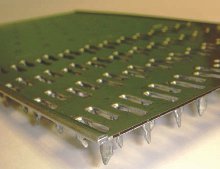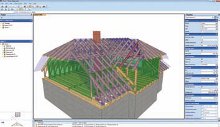Showing some metal
23 March 2013Connector plate and truss design software manufacturers have new products on the go. Stephen Powney reports
A team of 15 programmers at Wolf Systems has been working for the last 18 months on new "Fusion" software for the trussed rafter and easi-joist metal-web joist sector.
Fusion will replace existing Wolf trussed rafter and easi-joist design software.
"It's a very important project because the trussed rafter industry is very technology focused and we need to ensure they have the best technology to do their job," said Karl Foster, sales and marketing director at Wolf Systems.
Wolf hopes to show a first draft of Fusion to customers by the end of this year.
"At one time, trussed rafter manufacturing and easi-joist manufacturing were quite separate products and many of our customers had separate departments for them," said Mr Foster. "But the update to Wolf's truss design software WolfWin last year allowed easi-joists to be incorporated as elements into the roof, as well as pitched easi-joists."
Fusion will take that further into a full integrated design package for trussed rafters and easi-joists.
There are also other benefits for truss manufacturers in Wolf software - such as the Horizon timber frame software package.
"This year we have started to see a lot more interest in Building Information Modelling (BIM)," said Mr Foster. "There are some manufacturers now looking at the opportunities BIM could offer."
Horizon allows manufacturers to collaborate with architects and building contractors in a BIM environment.
Wyckham Blackwell - which produces trussed rafters, easi-joists and timber frame -is one such manufacturer doing this, using Horizon to generate trussed rafter information for BIM.
Wolf Systems has been active on metal connectors as well, further developing its Field Splice Plate innovation - which features a folded edge along the longest edge, effectively doubling the metal thickness (from 1.25mm to 2.5mm) in an area where strength is most needed.
Basically, the design is intended to provide a stronger nail plate using very little material.
Wolf is now rolling out its new Standard Splice Plate using the same feature of rolled edges.
"When timber is in tension, as in a splice connection, it's the thickness of the steel that resists the tension. If you can make the plate 2.5mm thick across the area that is most important you can get a smaller sized nailplate. It means clients are spending less and getting a more competitive product," said Mr Foster.
Wolf is currently examining packaging methods for the product, aimed at trussed rafter and easi-joist manufacturers, to maximise the number of plates which can be fitted in a box before launching the product commercially in the coming weeks.
Timber love affair
Mr Foster believes the trussed rafter industry needs to take a nod from the highly successful cross-laminated timber (CLT) construction sector in order to drive forward.
"A lot of the interest from blue chip clients like Marks & Spencer in timber in construction is in CLT. That's great but how does that reflect on our particular industry?
"As an industry we need to buy into that love affair with timber and make our products more attractive. Large section [CLT] timber construction projects are interesting and technical, but a bit of timber plated with a nailplate is just as technical, just not as sexy. We should be looking at this issue to drive our industry forward."
Mr Foster said Wolf had noticed that the most successful truss rafter manufacturers were the ones that were producing roof trusses and easi-joists.
"The most successful ones are the ones that are the most forward-thinking. With the market as it is at the moment, anyone who sits back and expects to get more revenue clearly has a fight on their hands. The way to expand is to innovate."
Meanwhile, fellow metal plate manufacturer and design software supplier MiTek Industries sees opportunities for trussed rafter fabricators in timber structures design code Eurocode 5 (EC5).
Although EC5 was introduced in 2010, the reality is that BS 5268 is still being used. MiTek's roof truss design software acknowledges this and allows companies to use either design codes.
"We believe EC5 does create some opportunities," said business development director James Morgan. "With BS 5268 span lengths revolve around domestic use of roofs in housing, whereas EC5 reflects a greater range of roofs, such as in Europe, where they are used to much larger structures, with spans of over 20m.
"That in itself presents a challenge for the UK trussed rafter industry. Over the last 40 years it has largely focused on smaller spans so there are not that many people with the equipment to make large span trusses. EC5 gives many more opportunities in the commercial sector."
MiTek will launch new roof truss design software -Pamir -in the UK next year.
The package is currently being released across Europe, with UK customers able to see demonstrations in April, while others will trial it before the UK commercial launch in 2014.
Mr Morgan said the main benefits were the faster speed of estimating roofs and the speed and flexibility of editing roof designs.
"A small design change like 50mm on the span may be a small thing but it creates a lot of work and may mean every truss of the roof has to be changed. So we have designed Pamir to be very flexible, it's very forgiving."
MiTek has also developed new types of connector plates over the last 12 months.
Tony Fillingham, MiTek technical services director, said its connector plate design work had included redesigning plates in the light of EC5, because the design properties of the latter meant the size of the plates was getting bigger.
He said redesigning the connector plate to keep the price down involved using less steel, but using high-tensile steel to keep the plates small.
Other MiTek news includes New European Technical Approval (ETA) for it's Posi-Joist open-web joist system, expected to be published at the end of March. The new ETA has increased scope from the original ETA, also covering use of Posi-Joists in roofs, MiTek's X-rafter cassette roof system and the Posi-stud.

